One Falcon 9 first stage has been launched and recovered 5 times!!


It depends upon a whole host of factors. As of April, 2020, quite a few USAF F-16's are capable of employing the AIM-120 D. I think the number is around 500. They don't have the AESA radar but from a mission computer and software perspective they can now carry and launch the weapon. In time radar and other upgrades will come as well. In the future, the F-16 will be gradually pushed out to the ANG units. Do all the Air National Guard F-16's really need the AIM-120D for their mission? Probably not. Will some of the units get it? Probably.ldev wrote:Will the upgraded USAF F-16s with the AN/APG-83 be armed with the 120D?
Thanks, very informative.brar_w wrote:It depends upon a whole host of factors. As of April, 2020, quite a few USAF F-16's are capable of employing the AIM-120 D. I think the number is around 500. In the future, the F-16 will be gradually pushed out to the ANG units. Do all the Air National Guard F-16's really need the AIM-120D for their mission? Probably not. Will some of the units get it? Probably.ldev wrote:Will the upgraded USAF F-16s with the AN/APG-83 be armed with the 120D?
But the USAF and USN have approx a 3,200 missile inventory for the AIM-120D at this point and the total projected inventory (before the US stops buying the weapon in Fiscal Year 25/26) is only around 9,000 in total so there likely will be some priority towards F-22's, F-15 E's and F-35's.
I think you are conflating issues here. Future proofing, the way I used it, is more having to do with upgrades and a technological road map being in place for that platform across its Life Cycle. The F-16 V is probably the last major upgrade the F-16 is going to go through. Tough to see anything else done to that platform. In the absence of a large, influential, and well resourced operator almost all the possible future technologies would remain un-integrated into the platform. This means that those few who may actually want it would not only have to pay, at times, to develop them but also to fully integrate them and test the aircraft etc. The USAF isn't even incorporating 100% of the Block 70/72 technologies. They are selectively choosing from the ones they think they'll need, to stay within an upgrade budget. In time, just like the F-15C's are currently (all but one squadron), the entire F-16 force structure would be transferred to the ANG. When that happens the resources available will diminish even further. So don't expect wholesale adoption of upgrade packages on those upgraded aircraft come 2030. As the airframes get older the business case for a major capability overhaul gets more difficult to make.V_Raman wrote:This future proofing business is overrated IMO. It is a foreign aircraft. We will have to pay arm/leg to upgrade it. M2K is the case in point. F16 can be upgraded as well if necessary with more modern avionics, radar, etc. in the future.
Sure it is. I never said that there were physical barriers (though there may well be in some areas) to F-16's being upgraded with technology that may be relevant in the decades to come. All I'm saying is that as users transition to the F-35 at a very fast pace, and as others delegate their F-16's to less important (at least from a resource allocation stand point) missions, those upgrades will continue to become more and more cost prohibitive. This is completely opposite to how F-16 upgrades have traditionally been. Its USP has been the very fact that it has a very large installed base and that a large portion of that (NATO Vipers) were at times in sync as far as their upgrade paths were concerned thereby bringing in economies of scale.V_Raman wrote:If Mig21 could be upgraded - anything is possible - at the right price!
Never said it was a slouch. It is a pretty capable aircraft with a lot of options in terms of systems and weapons. But these decisions mean that the platform will be in service for possibly 40 years. I can't even imagine what an F-16V MLU looks like in 2040, who buys it, and who pays for it. As I wrote in my prior post, affordability and cost are relative terms especially in the LCC things. Yes French upgrades will be expensive because they operate fewer Rafales than even the USAF's F-22A fleet. But at least the IAF won't have to go looking for them in terms if identifying technologies, and paying someone else to integrate them, or otherwise acquire the ability to integrate them in house. A large chunk of them will be done by the French given how important/critical the platform is to their Air Force. This is the same for the F-35 where Block 4 is now at full steam in terms of development even before many of the development partners have hit their FOC milestones. And Block 5 efforts are already being identified and they're getting ready to fund early work on them. So basically an entire 10-12 year product development and improvement/upgrade roadmap, much of it already funded, is ahead of that program. What's the equivalent of that in the F-16 world for the 2020's and into 2030s? This eco-system (however small or large it may be) won't exist for the F-16V in the future. There has to be some cost-consideration within the LCC calculation to account for this. Sure it may come in at say 70% of the upfront cost of the Rafale, but what portion of that upfront savings do you have to invest back in to the platform because you are left stranded as the only large operator who wants to insert some of the more challenging and expensive technologies , 10-15 years into the future? This is the same story as the MiG-35 but there you even lack any sort of installed base (at least the F-16V will have a decent installed base though not a huge one).V_Raman wrote:F16 is no slouch. If we wanted a ton of birds for lowest money - we could have made a g2g deal with the Americans. But it was too late.

The first example of the Taiwanese AT-5 advanced jet trainer (AJT) has flown for the first time. The maiden flight of the first of two flying prototypes, “A1”, took place on June 10 at Ching Chuan Kang air base, the Ministry of National Defense announced. Built by the Aerospace Industrial Development Corporation (AIDC), the AT-5 prototype flew for around 20 minutes, with its undercarriage extended throughout the flight. It was escorted by two examples of the two-seat F-CK-1D fighter upon which the AT-5 is based.
According to the state-owned Central News Agency, the flight was “the first of three days of tests being conducted by the air force before an official test flight is held on 22 June at the air base.” CNA further reported that “[the air force] has previously said the AJT has already cleared the required pre-flight dynamic and static tests.” Those static tests were conducted by the National Chung-Shan Institute of Science and Technology (NCSIST) on two static test airframes.
The Republic of China Air Force (RoCAF) is to procure 66 AT-5s to equip two units. One is currently based at Kangshan flying the AIDC AT-3 advanced trainer, and the other is at Taitung flying Northrop F-5E/Fs on weapons/fighter lead-in training. Both types are nearing the end of their service lives. Production of the AT-5 is due to start by the end of 2021 and run through 2026.
...
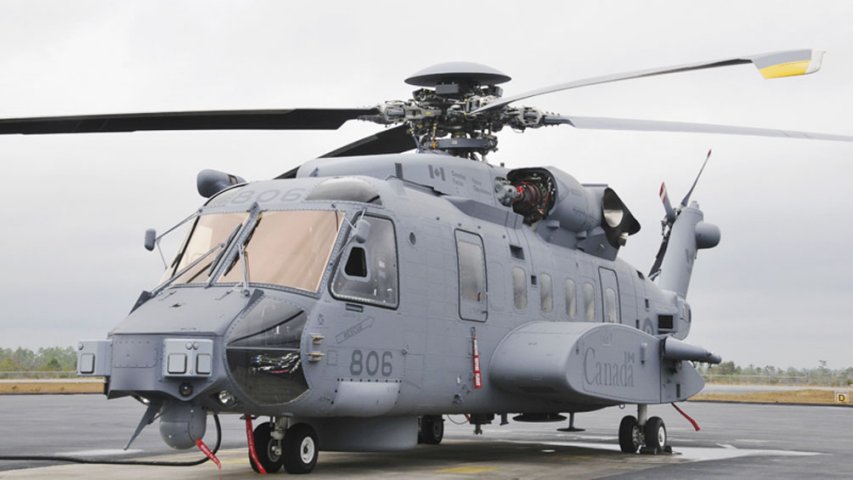
The Canadian Armed Forces (CAF) Sikorsky CH-148 Cyclone maritime and anti-submarine warfare (ASW) helicopter that crashed in the Ionian Sea on 29 April did not respond as the crew would have anticipated while performing a final complex manoeuvre turn to close with the HMCS Fredericton, according to a preliminary report.
The From the Investigator (FTI) report released 8 June determined that the CH-148 was returning from a routine surface reconnaissance mission followed by additional training of flight deck evolutions for aircrew proficiency before landing on the HMCS Fredericton. The helicopter had flown by the port side of the ship, from stern to bow, before making a left-hand turn to establish a downwind leg in preparation for approach to the ship.
The aircraft then began a final left turn to prepare for the approach. During this turn to close with the ship, the helicopter did not respond as the crew would have anticipated. This event occurred at low altitude, was unrecoverable, and the CH-148 entered a high-energy descent and crashed into the water astern the ship.
The investigation is ongoing and will focus on aircraft systems and human factors. The CAF fleet of CH-148 aircraft remains on an operational pause while the Royal Canadian Air Force (RCAF) investigates the cause of the crash.
TBG is the parent program/ transition program for ARRW as in TBG designs, develops, builds, and tests the BGV and guidance that goes into ARRW. The ARRW program (AGM-183A) is running in parallel, and focusing on a new booster, and aircraft integration. They are both literally running neck and neck and part of this may have been because ARRW finalization and work caused a slight delay to TBG because ARRW requires an entire industrial base to be created to produce weapons instead of just a BGV that comes out a lab or a prototype facility. TBG is expected (Lockheed variant) to begin flight testing this year (could happen any time now) and late next year for Raytheon's BGV design. ARRW has already begun its captive carry flight tests and will begin booster tests next year.Barath wrote:
Article also references the tactical boost glide (TBG) and ARRW (another boost glide) test/dev programs
WASHINGTON (Reuters) - The U.S. Senate Armed Services Committee said on Thursday it had authorized $9.1 billion to procure 95 F-35 aircraft in its version of the 2021 National Defense Authorization Act, or NDAA, an annual bill setting policy for the Department of Defense.
The 95 F-35s authorized in the bill are 14 more than requested by President Donald Trump’s administration.
The Senate committee also authorized the U.S. Air Force to keep six F-35s originally sold to Turkey.
Denmark has begun preparations for receiving its first Lockheed Martin F-35A Lighting II Joint Strike Fighter (JSF) combat aircraft, with the country’s parliament approving construction of facilities and the Royal Danish Air Force (RDAF) revealing the national livery to adorn the jets.
With the RDAF set to receive the first of its 27-contracted F-35As in 2021, the Danish parliament on 11 June approved legislation to build dedicated facilities at Skveststrup Flyvestation in Southern Jutland ahead of the commencement of type-operations there in 2023.
..

MOSCOW—Last week’s Russian Defense Ministry contract with Sukhoi for 20 Su-34 Fullback fighter-bombers is an interim step until development of a modernized variant is completed, an industry source tells Aerospace DAILY.
The Russian Air Force received the first Su-34 in December 2006. Based on the Su-27 Flanker airframe, the new fighter-bomber was designed to replace aging Su-24 tactical strike aircraft. After the preproduction batch of five aircraft, the military placed two larger orders for the new bomber—for 32 aircraft in 2008 and for 92 in 2012. The last four aircraft under the latter order are to be delivered this year, the source confirms.
The military planned to buy more Su-34s, but in a modernized variant equipped with new avionics and weapons. The CEO of Sukhoi parent United Aircraft Corp., Yury Slyusar, was cited by RIA Novosti in December 2019 as saying the new contract with the military was for deliveries of the upgraded Su-34M variant.
At the end of May, Russian media reports said such a contract could include 76 aircraft, with deliveries running through 2027. This deal was postponed as the development of the new version was not completed and the military had not yet defined the final configuration, a source says. So the Air Force preferred instead to order 20 aircraft from the future purchase in baseline configuration.
The Russian military currently operates about 120 Su-34 bombers. Although the type is based on Su-27UB design, it features a completely new forward section with a cockpit providing side-by-side seating for two-men crew, increased takeoff weight and combat load.
The upgrade to the Su-34M variant may include the installation of three types of Sych avionics, strap-on nacelles designed by NPO Mashinostroyeniya for electronic intelligence, and electro-optical reconnaissance and radar surveillance, according to media reports.
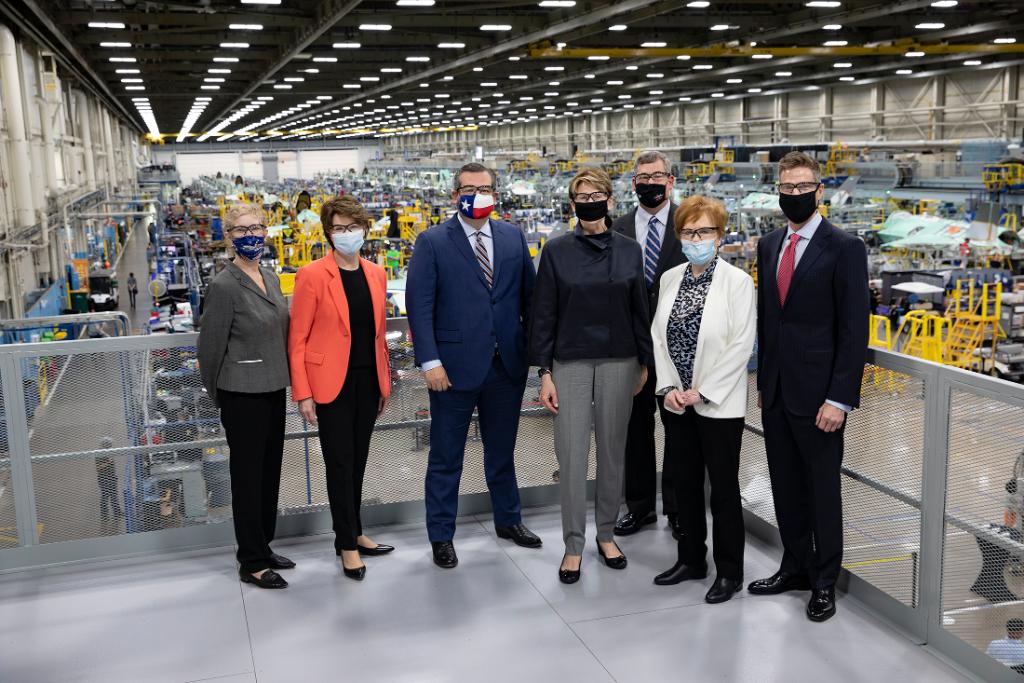
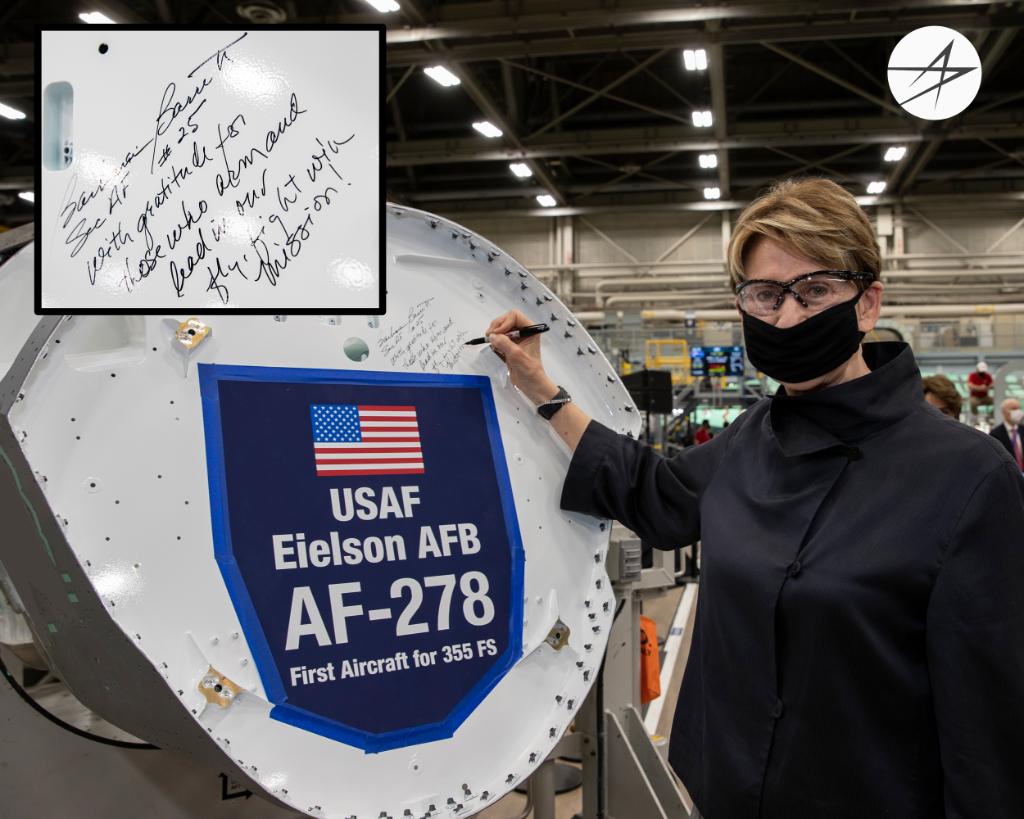
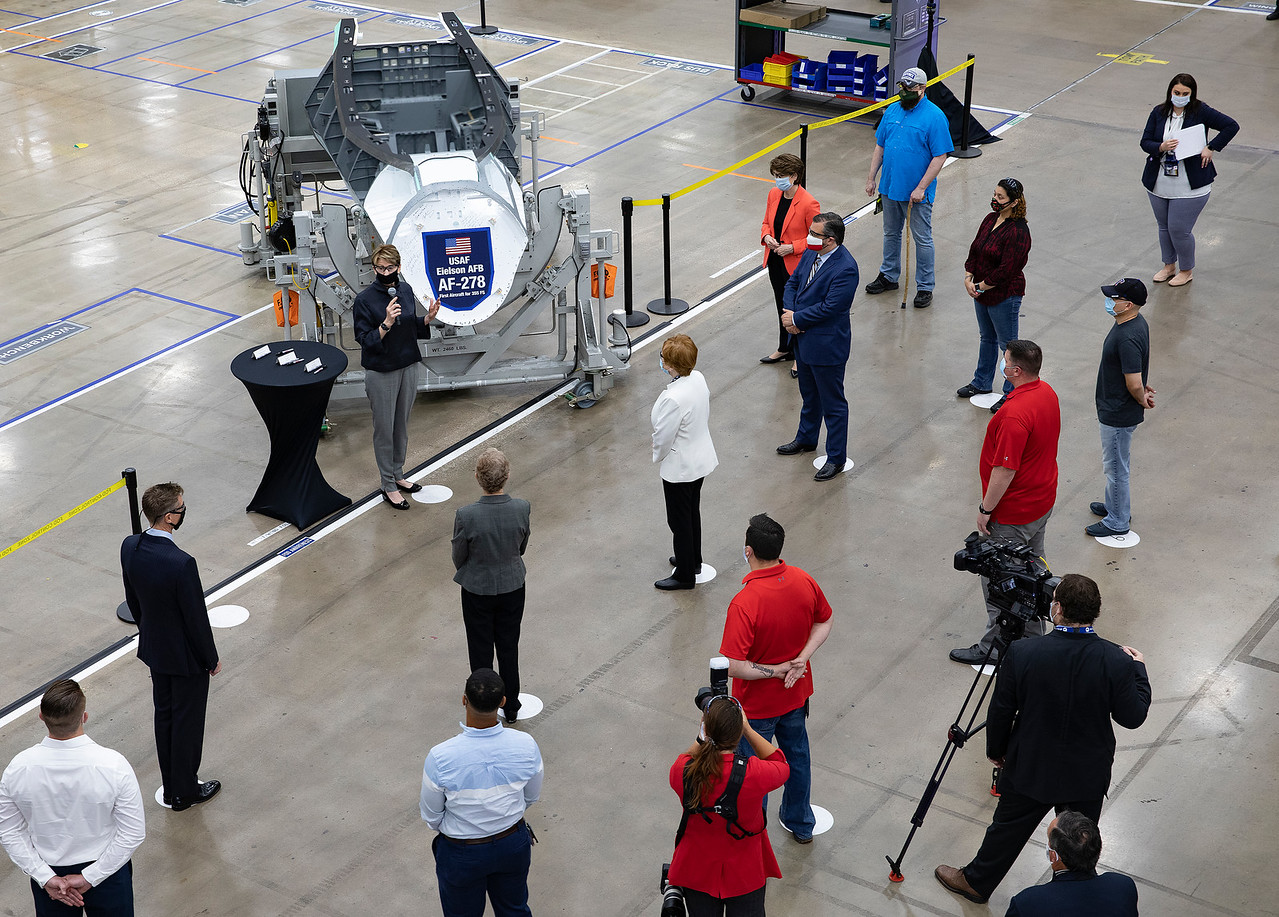
“Our focus on the students that go through TOPGUN is not limited to teaching them the tactics, techniques and procedures that are required for them to successfully employ their aircraft, integrated into a larger force,” said NAWDC TOPGUN Department Head, Cmdr. Timothy Myers. “We are also in the business of teaching our graduates how to instruct other students, so that when they go back to the Fleet, they are able to instruct at a very high level.”
For the last few years, NAWDC and TOPGUN have been working to develop the skill-sets, curriculum and experienced instructors required to execute a syllabus that fully integrates F-35C tactics, techniques and procedures. While all F-35C tactics instructors have completed the TOPGUN course previously, this is the first time TOPGUN has graduated students who are currently flying the Lightning II, utilizing a syllabus that has been developed, from the ground up, specifically for F-35C integrated operations. This was accomplished by the gradual introduction of F-35C tactics into the training curriculum for previous classes. The result is a cadre of highly-trained instructors executing a fully-integrated F-35C syllabus, providing well-rounded “graduate-level” training for the fifth-generation fighter to take back to the Fleet.
“Our focus is on assisting the SFTIs at the operational Fleet squadron, pushing the big picture tactics and ensuring that everything is ready to go for the first and subsequent F-35C carrier deployments,” said Goodwin. “The idea is that VFA-147 SFTIs can use the standards of tactical execution we provide to train their own people and take that knowledge with them through deployment. We are here to ensure that they are set up for success.”
This milestone is the latest feather in the cap for the U.S. Navy’s F-35C program. Since the stand-up of Commander, Joint Strike Fighter Wing in August 2018, the program has declared Safe-for-Flight Operations Certification (SFFOC) for both VFA-147 “Argonauts” and VMFA-314 “Black Knights.” In February 2019, the Navy and Marine Corps both declared Initial Operational Capability (IOC) for the F-35C and VFA-125, the F-35C fleet replacement squadron (FRS), graduated its first newly-winged F-35C aviators. In May 2019, VFA-101 “Grim Reapers” was deactivated, consolidating most of its resources at NAS Lemoore. Additionally, both VFA-147 and VFA-125 continue to meet program requirements, pass inspections, and receive certifications while continuously participating in numerous detachments both ashore and at sea.

The ASDRS consists of a pair of aluminum shrouds that can rotate and are mounted onto the exiting hose end of the refueling coupling. On these shrouds are pairs of lift and roll strakes, which are devices mounted to improve aerodynamics, driven by onboard direct current motors that, when rotated, produce the lift force and roll moments to counteract the disturbances. When not aerodynamically controlling the position, the strakes generate torque which is stored as power in onboard capacitors to drive the system.
Drogue position is monitored by a closed loop control that was developed over the last 10 years through SBIR contracts with AMA. This test entry was the first application where closed-loop control and position monitoring were demonstrated on a full-length hose and drogue setup.
LINK
The SB>1 Defiant compound helicopter reached 205 knots (235.9 mph) in a flight test last week, and it did so while running its engine at less than half power, Sikorsky test pilot Bill Fell said this morning. Once ground testing this summer confirms all systems are ready – and one such test was audibly whirring in the background as Fell spoke with reporters this morning – the aircraft will ramp up to full power over time, reaching a projected 250 knots (287.7 mph) “within a few months.”
By comparison, the UH-60 Black Hawk that Defiant is vying to replace maxes out at 193 knots (222 mph). So Defiant, a joint Sikorsky-Boeing product, is already faster than the Army’s current helicopters. But it’s not faster than Bell’s competing proposal for a Black Hawk replacement, the V-280 Valor, which has already exceeded the 280 knot (322 mph) goal for which it’s named....
The U.S. State Department has cleared Canada to purchase a package of upgrades for its fleet of CF-18 Hornets, including upgraded radars and weapons, intended to serve as a bridge between the legacy fleet and Canada’s future fighter.
The package, which comes with an estimated price tag of $862.3 million, would fulfill the requirements for Canada’s “Hornet Extension Project Phase 2,” which was announced last year. The program seeks to upgrade the “sensors, weapons, survivability, security and mission support to maintain parity with evolving threats” for 36 of Canada’s Hornets, with initial delivery in 2023, according to a statement on the Canadian military’s website.
Canada has 80 CF-18s in inventory and is in the midst of a long attempt to replace the aging fighters with 88 newer designs — one of which has been marred with restarts and political challenges. The Phase 2 extension is designed to help bridge the capability gap until new jets come online.
Among the upgrades included in this potential package: 50 Sidewinder AIM-9X Block II tactical missiles; 38 APG-79(V)4 active electronically scanned array radars; 38 APG-79(V)4 AESA radar A1 kits; 46 F/A-18A wide-band RADOMEs; upgrades to the Advanced Distributed Combat Training System; and technical assistance to support the upgraded jets.
“This sale will provide Canada a 2-squadron bridge of enhanced F/A-18A aircraft to continue meeting NORAD and NATO commitments while it gradually introduces new advanced aircraft via the Future Fighter Capability Program between 2025 and 2035,” said a statement from the Defense Security Cooperation Agency, using an acronym for the U.S.-Canadian North American Aerospace Defense Command.
The proposed sale of the capabilities, as listed, will improve Canada’s capability to meet current and future warfare threats and provide greater security for its critical infrastructure,” it added.
Work would be performed by Raytheon in its El Segundo, California, location; General Dynamics Mission Systems in Marion, Virginia; Boeing’s St. Louis, Missouri, facility; and Collins Aerospace in Cedar Rapids, Iowa. Any industrial offset agreements will be sorted out in the future.
Announcements of potential Foreign Military Sales deals are not final, and dollar amounts or quantities of items may change during final negotiation.
Raytheon’s Missiles & Defense business recently carried out the first guided release of a GBU-53/B StormBreaker smart weapon from an F/A-18E/F Super Hornet, which will become the second fighter to utilize the weapon when the program reaches initial operational capability later this year, the company said.
“StormBreaker is the only weapon that enables pilots to hit moving targets during bad weather or if dust and smoke are in the area,” said Cristy Stagg, the StormBreaker program director for Raytheon. “Super Hornet pilots will be able to use poor visibility to their advantage when StormBreaker integration is complete.”
During the U.S. Navy flight test, StormBreaker safely separated from the fighter and received guidance data from the plane, enabling it to be directed to its target while in flight.
StormBreaker, formerly known as Small-Diameter Bomb II, features a tri-mode seeker that uses imaging infrared and millimeter wave radar in its normal mode. The weapon can also deploy its semi-active laser or GPS guidance to hit targets.
The smart weapon gives operators the ability in combat to hit moving targets in some of the worst weather conditions. The winged munition autonomously detects and classifies moving targets in poor visibility situations caused by darkness, bad weather, smoke or dust kicked up by helicopters.
The weapon’s seeker works in three modes:
Millimeter wave radar detects and tracks targets through weather.
Imaging infrared provides enhanced target discrimination.
Semi-active laser enables the weapon to track an airborne laser designator or one on the ground.
The tri-mode seeker shares targeting information among all three modes, enabling StormBreaker to engage fixed or moving targets at any time of day and in all weather conditions.
StormBreaker’s small size enables the use of fewer aircraft to take out the same number of targets as larger weapons that require multiple jets. The weapon can also fly more than 45 miles to strike mobile targets, reducing the amount of time that aircrews spend in harm’s way.
The F-15E Eagle is the first platform to add StormBreaker; it’s also being integrated on the F-35 joint strike fighter.
Image from first flight/roll-out:The US Navy is welcoming its next generation multi-mission tactical fighter by taking delivery of the first Block III F/A-18 Super Hornet test jets this month, as part of its continuing effort to improve aircraft lethality, survivability, interoperability and sustainability in an ever-evolving threat environment.
Like every aircraft slated for the fleet, The Boeing Company-produced two-seat model (F287) and single-seat (E323) will undergo comprehensive testing. At Naval Air Station (NAS) Patuxent River, Maryland, Air Test and Evaluation Squadron (VX-23) will perform shore-based carrier testing and focus mainly on the hardware and aeromechanical aspects of test with the F model. At VX-31, located at Naval Air Weapons Station China Lake, California, teams will examine software functionality and network architecture, explained Capt. Mike Burks, F/A-18 E/F deputy program manager.
He added that once testing is complete at VX-23, the two-seated model will ferry to VX-31 to complete Block III flight testing.
“Now it’s up to our test squadrons and our integration team to verify requirements are met and ensure the engineering behind the Block III is validated prior to full-scale production and delivery of the Block III to the fleet,” said Burks.
While the jet’s exterior appearance is largely unchanged, Block III’s increased service life of 10,000 flight hours and reduced radar signature are accompanied by a new avionics suite that brings the Common Tactical Picture into the cockpit. Aircrew will also find an Advanced Cockpit System, with large touchscreen displays for improved user interface and more powerful computing through the Distributed Targeting Processor Network and Tactical Targeting Network Technology.
F/A-18 & EA-1G Program Manager (PMA-265) Capt. Jason Denney recalled Block III started as an unconventional acquisition program in support of maintaining improved aviation readiness and speed to the fleet initiatives as the Navy revamped its roadmap.
After leveraging nearly two decades worth of cost and production data, the award-winning NAVAIR contracts team was able to expeditiously award a roughly $4 billion multiyear procurement contract to Boeing in March 2019. For taxpayers, this provides significant cost savings in the form of bulk purchasing and long-range planning that capitalizes on existing production lines that will allow the Navy to acquire a minimum of 24 strike fighters each year through fiscal year 2021.
In addition to the Block III delivery, Boeing will also perform Service Life Modification (SLM) to hundreds of Block II Super Hornets that extend their service lives and integrate Block III capabilities. SLM is key in building both the capacity and capability to ensure the Navy has jets ready to fight out into the mid-2040s.
“These new capabilities are essential for ensuring we maintain the tactical advantage in the Great Power Competition. Block III production and SLM for our Block IIs also demonstrate contracting efficiency and solid partnerships with industry,” said Denney. “An all-around win for the Navy, for Boeing, and for the warfighter.”
The first squadron deployment of Block III Super Hornet is anticipated in mid-2023, with a plan in place to have two Block III squadrons, composed of new production and Block IIs that have undergone SLM, accompanying each Carrier Air Wing by 2027.
“It’s been an outstanding effort by thousands of people throughout the Navy and industry across America to reach this milestone, and their work is far from done,” said Denney.
“I have no doubt that the test squadrons and flight test engineers are eager to put these jets through their paces and make sure we’re bringing a highly capable and adaptable platform to the fleet with Block III.”
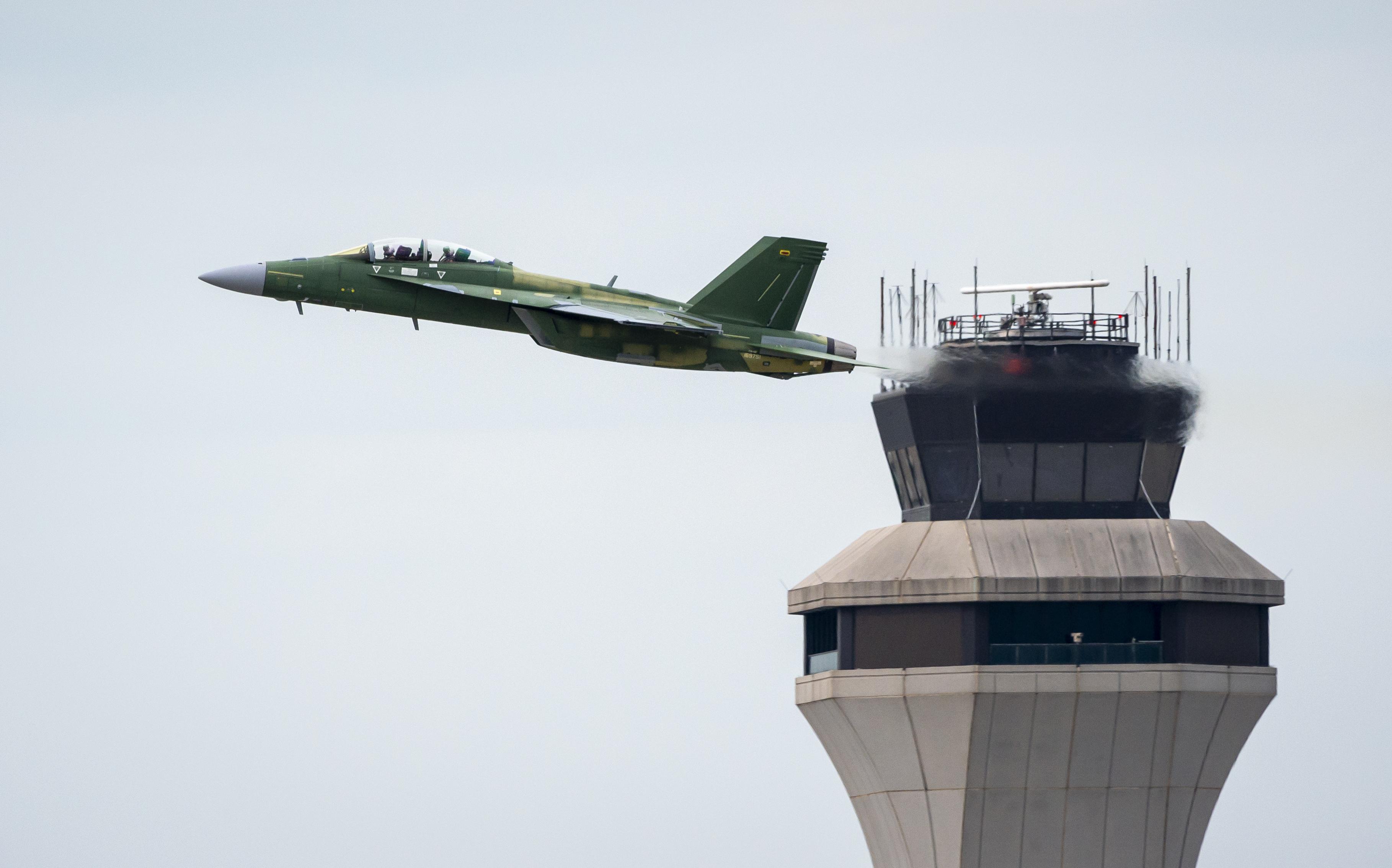
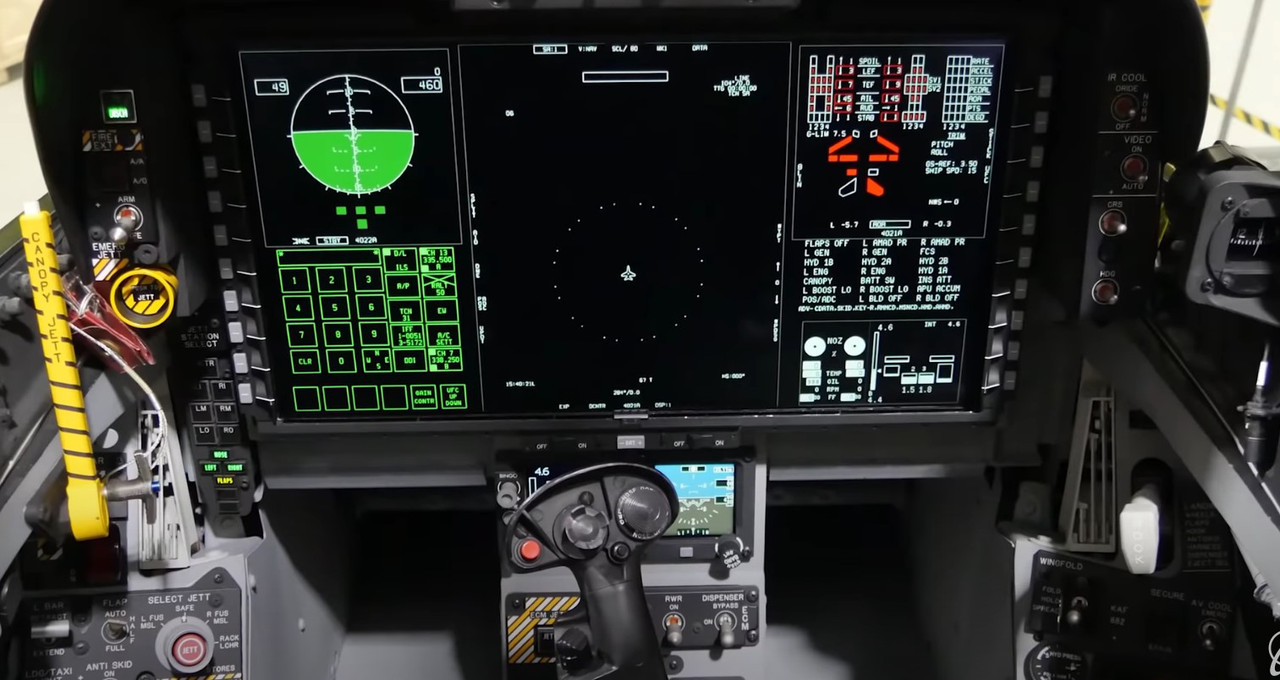
Five minutes. That’s the amount of time it took for Marines with Marine Wing Support Squadron (MWSS) 371 to refuel an F-35B Lightning II and get it back in the air. This was all part of a forward arming and refueling point (FARP) operation hosted by Marine Corps Air Station Yuma during which the tactical aviation ground refueling system (TAGRS) was employed.
A FARP is setup by a support squadron and can have one or several distributive fuel points across a landing zone that enable aircraft to land and obtain both fuel and ordnance during a mission.
“Our mission today was to support VMFA-122 with a one-point static-FARP,” said Staff Sgt. Steve Anderson, a bulk fuel specialist with MWSS-371. “We issue fuel to aircraft that come in to support their objectives in the area.”
The TAGRS was first implemented by MWSS-371 during Weapons and Tactics Instructor (WTI) Course 1-19 in October 2018. The TAGRS team, led by Chief Warrant Officer 2 Chris Moser, the MWSS-371 fuels officer, succeeded in reducing the one-point FARP establishment time by 90 percent and the total refueling time by 50 percent. During this recent FARP operation, the MWSS-371 Marines refueled each F-35B Lightning II in under ten minutes.
The TAGRS includes all of the refueling components in one compact system allowing for rapid setup and breakdown. This makes it essential for expeditionary advanced base operations (EABO) which seek to further distribute lethality in austere environments. The EABO concept advocates employing mobile, relatively low-cost capabilities such as the TAGRS to create a foot hold in order to extend the area of operations.
Cpl. Jesus Jimenez, a bulk fuel specialist with MWSS-371 explained, “It can pump fuel faster than the helicopter expedient refueling system, and it has four filter separators in it to filter out water and sediment, along with two points and two fire extinguishers. So we’re able to establish a FARP with just this system. All we need is a fuel source.”
The TAGRS and its operators are capable of being air-inserted making the asset expeditionary. It effectively eliminates the complications of embarkation and transportation of gear to the landing zone.
“What makes this system so unique is its mobility,” said Anderson. “We can pack the entire system in the back of a trailer and tow it into MV-22 Ospreys, CH-53 Super Stallions, or KC-130J Super Hercules, and drop it into an austere environment to extend the area of operations for aircraft so that they can attack further inland or pierce directly into the heart of the enemy.”...
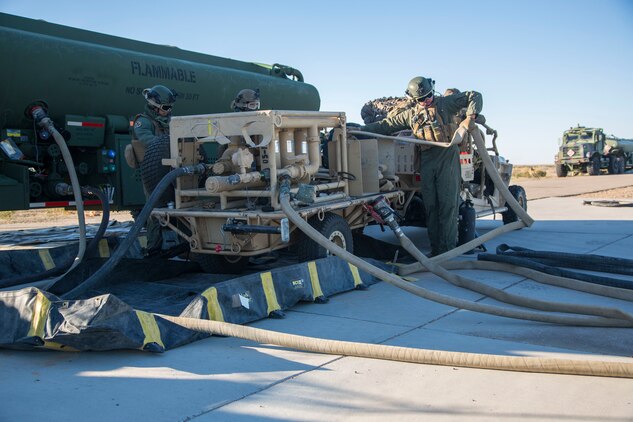
With operators in Europe, the Middle East and Asia looking on, an upgrade package approved by the State Department on June 16 for up to 36 Royal Canadian Air Force (RCAF) F/A-18C/Ds cements a new configuration aimed at keeping the Boeing-made jets in service decades beyond their planned retirement dates.
A group of Raytheon-made sensors and weapons—APG-79(v)4 active, electronically scanned array radars, AIM-9X Block II air-to-air missiles and AGM-154C Joint Standoff Weapons—will be included in the RCAF’s newly defined Phase 2 upgrade to help keep a subset of the 94-member CF-18 fleet operating into the 2030s. The State Department previously cleared Canada to acquire 32 AIM-120D advanced medium-range air-to-air missiles for the CF-18.
The package, defined in a Defense Security Cooperation Agency notification to Congress on June 16, offers few surprises. The Phase 2 Hornet Extension Program will be closely aligned with a U.S. Marine Corps initiative to keep at least two squadrons of F/A-18C/Ds in service beyond 2029, as both the Marines and the RCAF have waited longer than expected for a replacement jet to arrive.
The U.S. Navy tipped the radar selection for the RCAF in a June 11 presolicitation notice that specified the APG-79(v)4, showing an intent to prevent Northrop Grumman from offering the APG-83 for the Canadian program. The Marines evaluated the APG-83 and the APG-79 two years ago, but selected the latter as the successor to the Raytheon APG-73 for the “classic” Hornet fleet.
“Partnering with the [Marines], who are completing the same radar upgrade, will enable the introduction of this new capability faster, more efficiently and at reduced cost for both services,” the Canadian Department of National Defense (DND) tells Aviation Week in a statement.
The upgrades by the Canadians and the U.S. Marines are driven by the same issue. A delayed delivery schedule for the Lockheed Martin F-35B has forced the Marines to keep a fleet of Legacy F/A-18s in service for a decade longer than planned.
The Canadian government’s 11-year-old pursuit of a CF-18 replacement (highlighted by failed attempts to acquire 65 Lockheed Martin F-35As in 2010 and an interim fleet of 18 Boeing F/A-18E/F aircraft in 2016) is still in competition mode, with a contract award for 88 fighters due in 2022. Three bidding teams—F/A-18E/F, F-35A and the Saab JAS 39 Gripen—must submit final bids by July 31, which includes a one-month delay to account for the effect of the COVID-19 pandemic on the industry.
“These [CF-18] upgrades will provide a capability bridge until transition to a permanent replacement fighter,” the DND says.
Canada’s fighter delays have not been easy for the RCAF to manage. The current fleet, acquired in the early 1980s, was originally expected to be retired in the early 2000s. A retirement date in 2020 fell through as the government of former Prime Minister Stephen Harper stalled on signing the contract for the controversial F-35A selection. The new administration of Prime Minister Justin Trudeau pushed the selection process to 2022. The CF-18 is now set for retirement in 2032.
The situation is different in Finland. Although the Finnish Air Force operates the youngest fleet of F/A-18C/Ds, the head of the HX fighter competition has roundly rejected calls to extend their service life into the 2030s, saying even a few extra years of operations would cost at least €1.2 billion ($1.35 billion).
The State Department cleared the RCAF to buy 50 infrared-guided AIM-9X Block II missiles, 38 APG-79(v)4 radars and 20 AGM-154C glide bombs as part of an overall package worth $862 million. The bundle includes electronic equipment, tactical data and support.
The CAD$1.3 billion ($960 million) CF-18 Hornet Enhancement Program is divided in two phases. Phase 1 updates all 94 aircraft, including 18 former Royal Australian Air Force F/A-18C/Ds acquired two years ago, with interoperability and regulatory upgrades, including a new GPS/international navigation system, Identification Friend or Foe transponder, Link 16 tactical radios, satellite communications, targeting pod modifications and improved helmets.
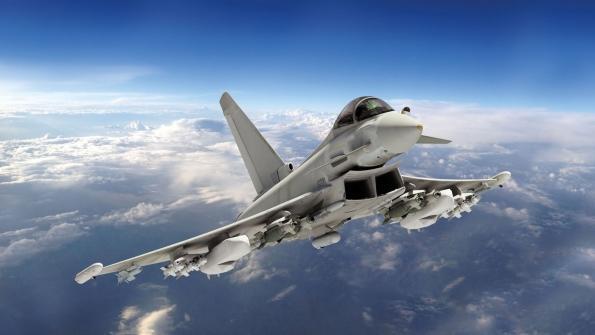
Germany’s plans to upgrade Berlin’s fleet of Eurofighters with the Captor-E active electronically scanned array (AESA) have been given a green light by lawmakers.
The decision means that Germany will be the first of the Eurofighter partner nations to retrofit the sensor. The approval paves the way for all 110 Tranche 2/3 Eurofighters to be upgraded with the Mk.1 version of the Captor-E, with first deliveries planned for 2023.
With the Parliamentary approvals on June 17, a contract with German defense electronics firm Hensoldt and Airbus is likely to be concluded in July. Hensoldt will be the design authority for the German radars and Airbus will run the test and integration elements of the upgrade.
The contract is likely to be worth around €2 billion ($2.2 billion), with the lion’s share, €1.5 billion, to go to Hensoldt.
“With this decision, Germany is taking on a pioneering role in the field of key technology for the Eurofighter for the first time,” Hensoldt CEO Thomas Müller said. “This will create high-tech jobs in Germany and give the Bundeswehr the equipment it needs to respond to new threats. In addition, it is a signal for Europe that Germany is investing in a technology that is of crucial importance for European defense cooperation.”
Airbus Defense and Space CEO Dirk Hoke welcomed the news, saying that the addition of the radar will increase the mission effectiveness of the aircraft and help integrate it with the Future Combat Air System in the coming years. Officials note that the upgrade plans could also help bolster export ambitions for the fighter as the consortium pushes to sell the Eurofighter to Finland and Switzerland.
The Captor-E radar has been developed by the Euroradar consortium led by Leonardo and includes Hensoldt and Indra. However, German Captor-Es Mk.1s will be produced by Hensoldt, although Leonardo will supply the radar’s processor and provide significant support to assist Hensoldt to take on the role of design authority.
The Captor-E is currently being developed in three versions. The Mk.0 will be delivered on the Eurofighter Typhoons destined for Kuwait and Qatar, with Kuwait expected to receive its first AESA-equipped aircraft later this year.
The Mk.1 radar is developed from the Mk.0 and features additional modes and a multichannel receiver. As well as being retrofitted to the German Tranche 2 and 3 aircraft, it will also likely be fitted on 38 new-build aircraft planned under Berlin’s Quadriga buy to replace its existing Tranche 1 Eurofighters, which lack the computing and electrical power for the AESA installation.
Work has also begun on the Radar 2 being developed for the UK, which will feature an electronic attack capability. It is due to be ready in the mid-2020s for use on British Royal Air Force Tranche 3 aircraft.
The Captor-E boosts the range and performance of the existing mechanically scanned Captor radar and adds a mechanical antenna repositioner, which gives the radar a much-increased field of regard compared to other AESA radar systems.
Germany has begun to hunt for a new maritime patrol aircraft after canceling a planned modernization of its Lockheed P-3C Orion fleet.
Airbus and Lockheed Martin were contracted by the German defense ministry in 2015 to undertake an eight-year-long, midlife update of the fleet, including rewinging to extend the life of the turboprop maritime patrollers by 15,000 hr.
But Berlin has grown concerned about the program’s cost and a series of technical difficulties, which have resulted in what German defense officials described as “insufficient operational readiness without any foreseeable improvement.” Documents published by the Germany defense ministry on program status suggest that delays related to the installation of avionics and sensors potentially added four years to complete the upgrade program, extending it from 2023 to 2027. Officials also note that one of the P-3s was badly damaged during a refueling process in March, further reducing the number of airframes available to them.
But a rewinging process on two of the aircraft will be completed.
The German defense ministry says that any anti-submarine and maritime patrol capability gap caused by the elimination of the P-3C “cannot be tolerated.” As a result, procurement officials have begun carrying out a “market review,” taking into account “all platforms available on the market.”
Although it has a relatively small coastline, Germany has always taken its maritime patrol capabilities seriously, particularly as a significant proportion of its exports leave the country via its northern ports.
Germany’s eight P-3s were introduced into service in 2005, having been purchased second hand from the Netherlands. The Orions replaced the Breguet Atlantic, which had served the German navy since the early 1960s.
The upgrade program had been envisioned to sustain the fleet through the mid-2030s, when it would have been replaced by a new multinationally developed multimission platform, the Maritime Airborne Warfare System (MAWS). MAWS would have possibly been based on the Airbus A320 airframe and replaced the French navy’s Dassault Atlantique. But the MAWS project’s future now looks less certain.
Last week The War Zone reported on intriguing tests involving Scaled Composites' high-flying Proteus test platform and the company's two Model 401 'Son Of Ares' stealthy jet demonstrators, which still largely remain a mystery. We can now say that these missions have not only continued, they have expanded to include new aircraft types.
This week, the trio of highly experimental aircraft were airborne once again over and near the Navy's massive Naval Air Weapons Station China Lake range complex in the Mojave Desert. Proteus and one of the Model 401s sortied from Scaled Composite's home base at Mojave Air and Space Port, while the other Model 401 flew out of China Lake, just like last time. But this time around they were joined by another player, a NASA F-15D Eagle carrying a large pod.
The appearance of a NASA F-15 for the tests is interesting. Nearby Armstrong Flight Research Center supports development and flight test work that have both civilian and military applications. Considering the exotic podded payloads Proteus often lugs around, which range between NASA scientific instruments to advanced military sensors, its involvement isn't too puzzling. Our photo contributor Christopher McGreevy found himself under the flight path of the F-15D and the Model 401 and captured a couple of photos of the formation:
According to local observers and plane trackers, the Model 401s flew together at times and separate at others and a KC-10 was present to provide fuel for the NASA F-15D as the tests wore on. Proteus was also close by at a similar altitude, around 25,000 feet, as the Model 401s, flying its large racetrack-like patterns oftentimes to the west of the action
Hans Friedel was near Mojave as this was going on and snapped some photos of one of the Model 401s and Proteus as they recovered at Mojave Air and Space Port. This is our first good look at N401XP in its configuration for these tests. Note that the aircraft wears a new overall gray coating and there are large discolored diamond-like shapes below the cockpit and on its lower tail section. It is unclear what exactly these patches are for, but it seems like the Model 401s may be participating in a test that at least has something to do with their signatures, which can include radar, electronic, infrared, and visual.
We also get a look at the other side of the pod Proteus is carrying, which appears to have some sort of electro-optical system installed. It's not clear if there is also a radar or some emitter situated in between, as well. If so, this would certainly help slew the optical systems on to their targets. With two apertures seen, it may make sense why two model 401s are participating in the test. The configuration would also point to why the planes are flying largely on the same plane as the cameras, if they are cameras, as they would have a limited ability to pan and tilt in this flush-mounted configuration. Still, we don't know for sure what the payload is or its utility for certain, so take all this with a grain of salt....
There has been much speculation that these aircraft could be manned or optionally manned demonstrators to prove unmanned technologies, such as the loyal wingman concept of operations and more. Like many other Scaled Composites other designs, their actual reason for being may be multi-fold or will shift over time.
Hanz also pointed out to us that the Model 401 sounds remarkably strange when landing and he even connected it to a video of an RQ-170 Sentinel landing at Creech Air Force Base some time ago that we have discussed here on The War Zone in the past.
It is not clear if the similarities are due to a common powerplant or the odd inlet designs on both aircraft, or even a combination of both, but it is interesting none the less.
So, that is where it sits now. There has been no action with the Model 401s today as far as we can tell, although Raytheon's 'Voodoo 1' 727 sensor test jet has been flying over the same area that Proteus was yesterday. It isn't clear if any of this is tied to the ongoing testing in question. Regardless, it seems clear that whatever program is underway involving these little stealthy jets it is a complex one that requires a large variety of assets and multiple test flights.


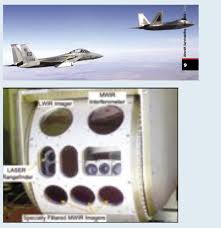

The images show a large portion of what is likely the Model 401 registered as N401XD—its twin is registered as N401XP—substantially mirrored over with dark coatings covering much of the remaining surfaces. It looks like some primer paint or another coating exists around the canopy bow and the leading edges of the dorsal jet air intake. It is unclear if the aircraft has the same application on both sides. This is undoubtedly one incredibly bizarre-looking treatment on an already alien-looking aircraft. The photographer who took the photos said the extremely bright glint coming from its fuselage made the aircraft very visible.
So, the question is, why mirror over a large portion a jet for a test? We can't answer that definitively, but we have some ideas.
The first would be to support laser testing. The Pentagon has a slew of directed energy efforts ongoing, including those in the air-to-air realm. Considering where the treatment is situated on the aircraft, the latter would seem like the most likely application. The pod hung under Proteus for the tests appears to have two large dark lenses and one smaller one that could be indicative of cameras needed to record a laser test. They are fixed and facing directly to the side of the aircraft, so recording another aircraft would make sense here especially considering that the Model 401 jets and Proteus have been flying at around the same altitude, but offset laterally to varying distances.
The pod does have a large sliding door on the bottom, a feature that is usually associated with electro-optical systems. As to whether it holds a directed energy turret is unknown, but we do know that the demonstrators were flying with a NASA F-15D recently that was carrying an unusual pod that looks similar to one that may hold a laser system (see below)...
The other thought we had is that this could be part of an ongoing test of infrared sensors, quite possibly infrared search and track (IRST) systems that are going to be fielded very soon within the Air Force and Navy. By using different coatings, including one that is blindingly effective, it could push the sensor to its limits and could help uncover hardware flaws and software issues that could occur in a real-world environment with the system.
A mirrored aircraft, in particular, may prove to be a unique challenge for these systems, and flying one alongside an exact copy of that aircraft without the treatment could provide a control variable to test against. The two Model 401s have been flying together for much of the testing that has occurred, according to flight tracking software. This would also help explain Proteus' pod with the dark optical windows, which would house the infrared sensors, as well as the reason for other aircraft to take part in these tests, including F-117s, which have a reduced infrared signature not commonly found on combat aircraft....
That doesn't mean that the trainer had a "lesser" requirement. In a competitive landscape these are actually very hard requirements (balancing performance with affordability) That just meant that HAL was thinking about (but didn't actually participate) entering a combat aircraft for a trainer competition and requirement.arvin wrote:As per this link, Group Captain HV Thakur, deputy chief test pilot, HAL says
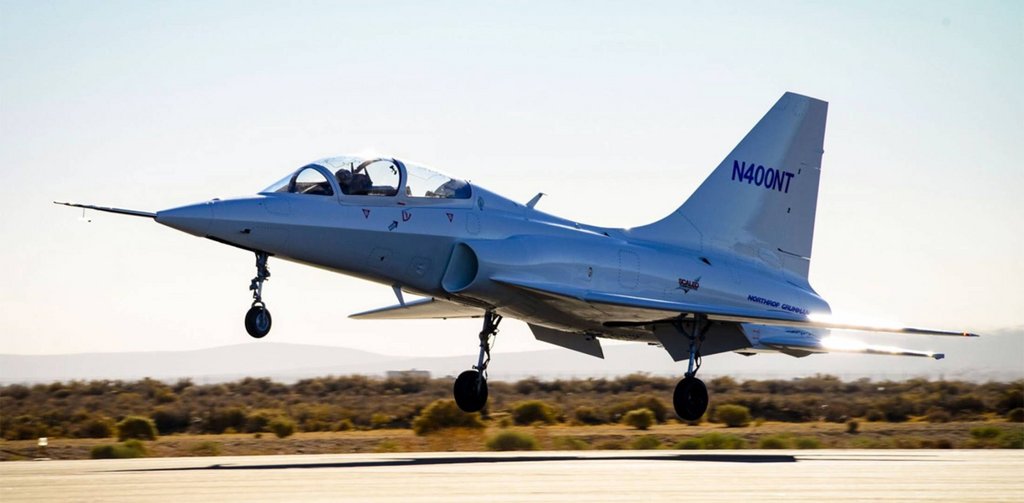
USN will develop its own trainer requirements. Right now, they don't want carrier compatibility. This is because as they bring in a new aircraft they will free up lot of current utilization of the T-45 allowing that type to handle that part (carrier) of the syllabus for a longer period. This will give them plenty of time to field a sub-variant of the eventual aircraft they buy. This is smart, as this allows them to leverage the Economies of Scale as the T-7A line is built to support a production rate of 60 aircraft per year. And they will maintain 100% commonality over the training system portion of the program which by cost represents almost 20% of the entire USAF program.USN trainer (T-45) requirement is up next with usual suspects above in the fray. None of them are carrier capable. HAL will miss this bus too despite having LCA NP-1.
HAL could have. But even assuming that HAL was a private corporation that is just getting started with designing --> producing aircraft at scale, the business case for pursuing such a program, for such a requirement, would have been shaky at best. Boeing literally designed and built the BTX using their own funding and have been flying the 2 prototypes non stop ever since they rolled out on company funding. But for them, the business case was easier to make to their shareholders.HAL could have thrown $ on this dedicated trainer version to create a T-50 competitor early on say post 2010 instead of focussing on HAwk-i which I believe is purely internally funded .
It would be interesting to follow this and sees where it goes. There are two broad types of trainer requirements globally. One where the user is looking at the cheapest possible trainer, given a set of training needs, and another where they are putting a value on residual combat capability and shared platforms. Traditionally, the market has responded to the latter by fielding combat capable versions of their trainers. M-346 has it, Hawk has it as well and the T-50 and F/A-50 is sort of the capability leader in that market segment.arvin wrote:The Supersonic Omni Role Trainer Aircraft (SpORT), a lead-in ..
Read more at:
http://timesofindia.indiatimes.com/arti ... aign=cppst
I don't think being carrier capable is a major consideration for either of them. You don't require an aircraft that needs to "live" on the carrier. It only needs to be capable of landing, and taking off using the arresting cable, steam and EMALS cats. It need not be capable of sustaining long deployments at sea or perform combat missions so Boeing need not propose complex overhauls to how the aircraft is sustained (on land vs at sea sustainment differences) or figure out what changes need to be made to integrate the aircraft into carrier sustianment operations. It will require a series of much simpler design changes that just cater to one aspect (taking off and landing on a carrier) and not the plethora of design changes that one needs to do to convert a land based combat aircraft to one that can function on an aircraft carrier.HAL will miss this bus too despite having LCA NP-1.
Yeah that and probably other things as well. Interestingly, if you look at what Northrop developed for this competition (they designed their product much ahead of mature requirements), there you'll see a predominantly composite design. The one-piece, three-spar composite wing structure and other design changes they made were probably with cost, and weight in mind. Boeing optimized its design for the maneuvering, speed and high alpha performance the USAF desired and they kept it low cost by just keeping it simple which will make it cheaper for them to build at scale (USAF wants a peak production rate of 60/year) and for USAF maintainers, who are moving from the T-38 Talon, to maintain it with less of a learning curve than what something that utilizes advanced composites would have entailed. So it is a win-win. They also shaved design and test time by borrowing parts from other programs already on contract (like the F-16's landing gear).arvin wrote:Thanks brar for the great post. Things much clearer between Tejas which is combat optimized, composite make and T-7 which is training optimized and aluminium make.
Yes as a bonus it can be used as a bomb hauler with no extra investment made in design. Considering it was able to shave off $10 billion from USAF planned estimated cost by frugal engineering it will be reluctant to put any more money for upgrade and will only be interested in recoveries.brar_w wrote:
Now if Boeing were to make a combat aircraft derivative they would be at a major disadvantage in terms of weight that they could have shaved off had they gone in for composites but even in the most unlikely/rare scenario any combat capability demand for this platform will essentially be for a bomb hauler (as opposed to a full fledged combat fighter) or perhaps a red-air adversary aircraft so none of that is going to matter a whole lot. So they have an advantage with this trainer_optimized/centered design because it has the performance that places it at the top of the trainer market, and given EOS and some of the design decisions Boeing made, they can churn it out at a fly away cost of around $20 Million a pop and the USAF's (and probably USN's) installed base will be attractive for product support and future enhancements.
M-346 didn't withdraw. The initial partnership with GD soon evaporated once initial requirements were revealed. Raytheon would have happily accepted Leonardo's terms had the aircraft and proposal been competitive. As it is, there were likely some exceptions made to the final RFP to fully accommodate it (see below). Some of the requirements shared in the initial RFIs from back in 2016/17 would have made it tough for the M-346 to compete. Probably still, I doubt that Leonardo fully supplied actual flight test data for what they were proposing. It was likely a mix of baseline data on the current aircraft with some changes and their potential impact. Boeing flew just enough flights to supply 100% of the data the USAF demanded. Lockheed did the same with the T-50 they brought in to the US.arvin wrote:The reason M346 withdrew from the contest was also money, since Raytheon wanted to cut leonardo's idea by as much as 30%.
The sustained G requirement was specified at 15,000 ft altitude, sustained for a minimum of 140 degrees of a 180 degree turn (if you hit say 6.5 G for less than 140 degrees, and 6 G's for the remainder of the 180 degree turn, you would be scored as 6G capable) with no more than a 2,000 ft loss in altitude (at the end of the maneuver) and no more than 10% of the 0.9 Mach entry speed should have been lost. It is believed that Boeing was chasing the objective (7.5 G) for this requirement as this offered the biggest upside in terms of receiving credit for achieving objective, as opposed to threshold, performance. Again, the challenge wasn't meeting performance but doing so without breaking the bank as your bid was a FIRM FIXED PRICE bid and if you were selected as the lowest bid ( with adjustments made downwards to account for higher performance so second or third lowest bid could have been judged as best value) you had to deliver on the promised price, volume and schedule.The US Air Force is not backing away from the ambitious sustained g requirement for its T-X next-generation trainer that has sidelined at least two proposed aircraft types and driven competitors toward clean-sheet designs...
However, the service's initial set of requirements – posted in March – narrowed the field and caused the primes to reassess their initial offers, with General Dynamics parting ways with Alenia Aermacchi and Northrop reconsidering its Hawk offer in favour of a clean-sheet design.
In a 10 July statement, the Air Education and Training Command (AETC) confirmed that the minimum T-X sustained g requirement of 6.5g and objective of 7.5g remains unchanged from the key performance parameter published in March, even though it would exclude a number of viable trainer options from the competition...
This pushes out the T-100, which its Italian manufacturer says can sustain 5.3g at 15,000ft. The Hawk is also out of the race. "If you score us on how much sustained g you can pull, we'll lose every time,” one BAE business development manager told Flightglobal back in 2011.
Boeing and Saab, Northrop Grumman and Lockheed have each said they are working on clean-sheet designs, although the nimble Lockheed-KAI T-50 still appears to be a viable contender.
LINK
I think it is reasonable to deliver value by undercutting competition on cost, if you can't deliver the same via better performance. If you are near the bottom in terms of performance (once BAE decided not to bid the M-346, as capable as it is, was near or at the bottom), and near the top in terms of price then that doesn't really help much at all.arvin wrote:The reason M346 withdrew from the contest was also money, since Raytheon wanted to cut leonardo's idea by as much as 30%.